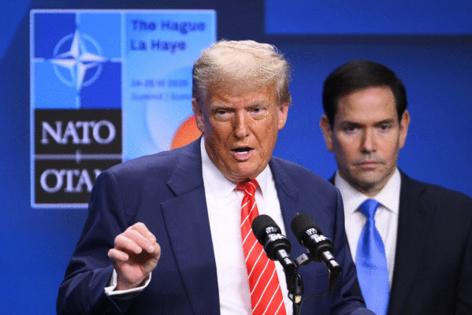Editorial: The fight to revive Europe's militaries is just beginning
Published in Op Eds
The pledge by NATO members to spend 3.5% of gross domestic product on military capabilities and 1.5% on defense infrastructure is the alliance’s boldest commitment in decades. It concedes a basic truth: Russia’s war in Ukraine has exposed critical shortfalls in Europe’s defenses at a time when U.S. support has become less certain. The challenge now is to translate that ambitious target into deployable firepower fast enough to meet the threat.
The starting point is finding the money to meet the new commitments. France, Italy and the UK already run heavy budget deficits. Spanish Prime Minister Pedro Sanchez is claiming his country has eked out a concession to spend just 2.1% of GDP. Over time, Germany’s weak growth and fractious politics could undermine its resolve, despite the loosening of its debt brake. Discipline, and likely continued pressure from the U.S., will be required to ensure members don’t renege on their spending promises.
Even more important will be spending the money wisely. The first task must be to address Europe’s fragmented defense industrial base and the duplication of weapons systems. The region produces more than a dozen main battle tank variants and is pursuing two rival sixth-generation fighter programs — the Future Combat Air System (France, Germany, Spain) and the Global Combat Air Program (Britain, Italy, Japan).
Some progress is being made, such as the pooling of ammunition orders by Nordic states through Norway’s Nammo AS. And 19 EU countries are funding joint drone and electronic warfare projects through the European Defense Agency, an EU body. Yet these efforts are small-scale; fewer than 1 in 5 equipment purchases by European Union members (23 of 27 EU members are in the North Atlantic Treaty Organization) are made jointly. NATO members will need to launch more joint tenders, cap the number of platforms per class and insist that new gear be interoperable.
European members should also acknowledge where domestic production makes sense and where it doesn’t, rather than insisting on broad “buy European” provisions. Europe still relies on the U.S. for a range of critical needs from air and missile defenses to cyber and electronic warfare, as well as intelligence, surveillance and reconnaissance. Countries should continue buying critical capabilities from the U.S. and license production locally where possible. A new venture between Rheinmetall AG and Anduril Industries Inc., for European production of U.S. drone designs, shows how pragmatic technology sharing can bridge gaps while local industry scales.
Progress will need to be carefully monitored, not just in spending levels but also in weapons delivered. NATO’s classified capability reviews should be distilled into an annual public scorecard for taxpayers to review. Governments should also be forced to show that the funds designated for infrastructure are actually going to reinforce rail beds, widen tunnels and build logistics hubs — all essential to address shortcomings in military mobility — rather than politically driven projects rebadged as defense.
Finally, European leaders must be honest with themselves and, most important, with voters. While defense R&D can spin off useful breakthroughs that benefit the broader economy, military outlays rarely deliver the jobs boost that investments in health care or green energy can. Massive defense spending is and should be defended as insurance against Russian aggression, not as a quick fix for stagnant growth.
NATO leaders deserve credit for overcoming parochial concerns and political resistance to agree on the new spending targets. They should recognize, however, that their fight has only just started.
_____
The Editorial Board publishes the views of the editors across a range of national and global affairs.
_____
©2025 Bloomberg L.P. Visit bloomberg.com/opinion. Distributed by Tribune Content Agency, LLC.

























































Comments